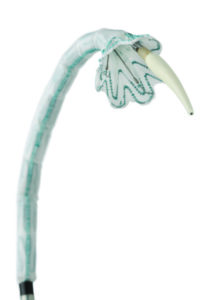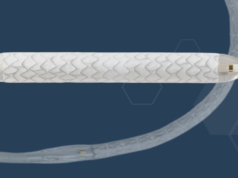 In the wake of approval by the Food and Drug Administration (FDA) of the Treo abdominal aortic stent-graft system for the treatment of patients with abdominal aortic aneurysms (AAAs), Terumo Aortic has announced the publication of the primary endpoint results from the investigational device exemption (IDE) pivotal study in the Journal of Vascular Surgery.
In the wake of approval by the Food and Drug Administration (FDA) of the Treo abdominal aortic stent-graft system for the treatment of patients with abdominal aortic aneurysms (AAAs), Terumo Aortic has announced the publication of the primary endpoint results from the investigational device exemption (IDE) pivotal study in the Journal of Vascular Surgery.
Over a three-year period, a multicenter, non-randomized, investigational device exemption (IDE) pivotal study assessed the safety and effectiveness of the Treo device, the device maker explained.
A total of 150 patients with infrarenal abdominal aortic or aorto-iliac aneurysms were treated in 29 centers across the U.s. Follow-up continues but the primary safety and effectiveness endpoint analysis is now complete and demonstrated 100% technical success, 0.7% incidence of major adverse events at 30 days, and 93.1% successful aneurysm treatment at one year.
In line with previous studies such as the global RATIONALE registry, a high percentage of patients had positive aortic remodeling with 54.3% who had aneurysm sac shrinkage >5mm at three years.
One of the study’s authors, Michael C. Stoner, MD, chief of vascular surgery at the University of Rochester in Rochester, New York, commented: “Worldwide experience with this device along with publications from our groups have already suggested that Treo is linked to positive remodeling.
“Certainly, data to three years in the IDE study are in line with those earlier findings and, as we gain more experience with Treo, it will be beneficial to develop an even better understanding of the physiological factors contributing to sac regression.”
Terumo announces completion of RelayPro–T IDE enrollment Stateside
 Meanwhile, Terumo Aortic also announced the completion of enrollment of the RelayPro Traumatic Injury (RelayPro–T) Investigational Device Exemption (IDE) study in the U.S.
Meanwhile, Terumo Aortic also announced the completion of enrollment of the RelayPro Traumatic Injury (RelayPro–T) Investigational Device Exemption (IDE) study in the U.S.
The thoracic stent-graft device is designed to expand the treatment of thoracic endovascular aortic repair (TEVAR) to patients with smaller access vessels.
The RelayPro-T study has enrolled a total of 50 patients with traumatic injury of the descending thoracic aorta at 16 sites across the country.
The prospective, multicenter, non-blinded, non-randomized study is set to analyze endovascular repair of traumatic aortic injury, or transection, usually caused by high-speed impacts such as those in road traffic accidents or serious falls.
The primary endpoint of the trial is all-cause mortality at 30 days, with follow-up continuing for five years.
“This is an important landmark in moving this device along the regulatory pathway and making it available to surgeons throughout the United States to treat these emergency cases,” said co-national principal investigator, Benjamin W. Starnes, MD, chief of the division of vascular surgery at the University of Washington in Seattle.
“The Relay device has already shown outstanding navigability, total accuracy and less risk of air embolism thanks to its unique dual sheath design. In addition, the low profile of the RelayPro device will make it suitable for more patients.”
Fellow co-national principal investigator, Ravi Rajani, MD, chief of vascular and endovascular surgery at Grady Memorial Hospital in Atlanta, added: “The endovascular management of traumatic aortic injury has the potential advantages of less morbidity due to smaller incisions as well as shorter operating times.
“A device that can further improve on these advantages with a lower profile and a more flexible delivery system will be a welcome addition to our treatment options. Greater spacing between stent zones makes it more conformable to the aortic wall, even in the highly angled aortic arch of the typically young trauma patient.”












